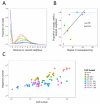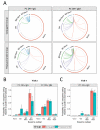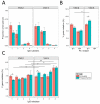BCR repertoire sequencing: different patterns of B-cell activation after two Meningococcal vaccines
- PMID: 25976772
- PMCID: PMC4551417
- DOI: 10.1038/icb.2015.57
BCR repertoire sequencing: different patterns of B-cell activation after two Meningococcal vaccines
Abstract
Next-generation sequencing was used to investigate the B-cell receptor heavy chain transcript repertoire of different B-cell subsets (naive, marginal zone (MZ), immunoglobulin M (IgM) memory and IgG memory) at baseline, and of plasma cells (PCs) 7 days following administration of serogroup ACWY meningococcal polysaccharide and protein-polysaccharide conjugate vaccines. Baseline B-cell subsets could be distinguished from each other using a small number of repertoire properties (clonality, mutation from germline and complementarity-determining region 3 (CDR3) length) that were conserved between individuals. However, analyzing the CDR3 amino-acid sequence (which is particularly important for antigen binding) of the baseline subsets showed few sequences shared between individuals. In contrast, day 7 PCs demonstrated nearly 10-fold greater sequence sharing between individuals than the baseline subsets, consistent with the PCs being induced by the vaccine antigen and sharing specificity for a more limited range of epitopes. By annotating PC sequences based on IgG subclass usage and mutation, and also comparing them with the sequences of the baseline cell subsets, we were able to identify different signatures after the polysaccharide and conjugate vaccines. PCs produced after conjugate vaccination were predominantly IgG1, and most related to IgG memory cells. In contrast, after polysaccharide vaccination, the PCs were predominantly IgG2, less mutated and were equally likely to be related to MZ, IgM memory or IgG memory cells. High-throughput B-cell repertoire sequencing thus provides a unique insight into patterns of B-cell activation not possible from more conventional measures of immunogenicity.
Figures






Similar articles
-
A Reassessment of IgM Memory Subsets in Humans.J Immunol. 2015 Oct 15;195(8):3716-24. doi: 10.4049/jimmunol.1500753. Epub 2015 Sep 9. J Immunol. 2015. PMID: 26355154 Free PMC article.
-
Meningococcal serogroup C immunogenicity, antibody persistence and memory B-cells induced by the monovalent meningococcal serogroup C versus quadrivalent meningococcal serogroup ACWY conjugate booster vaccine: A randomized controlled trial.Vaccine. 2017 Aug 24;35(36):4745-4752. doi: 10.1016/j.vaccine.2017.06.053. Epub 2017 Jun 28. Vaccine. 2017. PMID: 28668575 Clinical Trial.
-
Next-generation sequencing analysis of the human T-cell and B-cell receptor repertoire diversity before and after hepatitis B vaccination.Hum Vaccin Immunother. 2019;15(11):2738-2753. doi: 10.1080/21645515.2019.1600987. Epub 2019 Jul 25. Hum Vaccin Immunother. 2019. PMID: 30945971 Free PMC article.
-
The sequences encoded by immunoglobulin diversity (DH ) gene segments play key roles in controlling B-cell development, antigen-binding site diversity, and antibody production.Immunol Rev. 2018 Jul;284(1):106-119. doi: 10.1111/imr.12669. Immunol Rev. 2018. PMID: 29944758 Review.
-
Identification of Antigen-Specific B-Cell Receptor Sequences from the Total B-Cell Repertoire.Crit Rev Immunol. 2015;35(6):463-78. doi: 10.1615/CritRevImmunol.2016016462. Crit Rev Immunol. 2015. PMID: 27279044 Review.
Cited by
-
Maturation of the Human Immunoglobulin Heavy Chain Repertoire With Age.Front Immunol. 2020 Aug 6;11:1734. doi: 10.3389/fimmu.2020.01734. eCollection 2020. Front Immunol. 2020. PMID: 32849618 Free PMC article.
-
Deep Characterization of the Human Antibody Response to Natural Infection Using Longitudinal Immune Repertoire Sequencing.Mol Cell Proteomics. 2020 Feb;19(2):278-293. doi: 10.1074/mcp.RA119.001633. Epub 2019 Nov 25. Mol Cell Proteomics. 2020. PMID: 31767621 Free PMC article.
-
Capturing the differences between humoral immunity in the normal and tumor environments from repertoire-seq of B-cell receptors using supervised machine learning.BMC Bioinformatics. 2019 May 28;20(1):267. doi: 10.1186/s12859-019-2853-y. BMC Bioinformatics. 2019. PMID: 31138102 Free PMC article.
-
Structural diversity of B-cell receptor repertoires along the B-cell differentiation axis in humans and mice.PLoS Comput Biol. 2020 Feb 18;16(2):e1007636. doi: 10.1371/journal.pcbi.1007636. eCollection 2020 Feb. PLoS Comput Biol. 2020. PMID: 32069281 Free PMC article.
-
B-cell immune repertoire sequencing in tobacco cigarette smoking, vaping, and chronic obstructive pulmonary disease in the COPDGene cohort.Front Immunol. 2025 May 2;16:1508786. doi: 10.3389/fimmu.2025.1508786. eCollection 2025. Front Immunol. 2025. PMID: 40386772 Free PMC article.
References
-
- Galson JD, Pollard AJ, Trück J, Kelly DF. Studying the antibody repertoire after vaccination: practical applications. Trends Immunol. 2014;35:319–331. - PubMed
Publication types
MeSH terms
Substances
Grants and funding
LinkOut - more resources
Full Text Sources
Other Literature Sources

